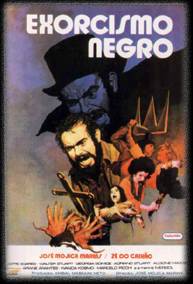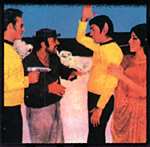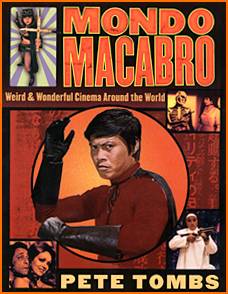 Marrie Lee as Cleopatra Wong
Marrie Lee as Cleopatra Wong 
(Philipines, 1977).
Now, in his new book, Mondo Macabro: Weird & Wonderful Cinema Around the World, Pete Tombs picks up where Immoral Tales left off as he covers the erotic horror and fantastic cinema of nine additional countries--Hong Kong, the Philippines, Indonesia, India, Turkey, Brazil, Argentina, Mexico, and Japan. And what a strange trip it is indeed. Tombs introduces us to some of the most unusual and startling movies ever made. He has "sifted through the dross" of the world's fantastic cinema "and picked out the dusty jewels." You can "simply gawp at the sheer awfulness" of some of the movies while "marvelling at the sheer weirdness of others."

 Poster artwork for Jose Mojica Marins' Black Exorcism (Brazil, 1974).
Poster artwork for Jose Mojica Marins' Black Exorcism (Brazil, 1974).
If, for example, your experience of fantastic Japanese cinema is limited to giant monsters stomping on scale models of Tokyo, then an entire separate world of cinema awaits you. It's a cinema of lovelorn ghosts, vengeful cat spirits and murderous samurai. Some of the titles will be familiar to lovers of international cinema, such as Kenzi Mizoguchi's Ugetsu Monogatari, but most of the titles will be familiar to only a few English-speaking readers. Mogu, for example, (based upon one of the stories of the famous Japanese writer Edogawa Rampo) tells the story of "a blind sculptor obsessed by the body of a young model that he knows only through touch. He kidnaps the girl and imprisons her in a large room. To her horror she discovers that the walls of the room are covered in huge casts of body parts: eyes, legs, noses, arms. The rest of the space is taken up with two huge rubber statues of female bodies. The girl attempts to escape and she and the blind man play a bizarre game of tag, chasing each other over the mountainous limbs of the giant rubber statues. Eventually the girl agrees to let the man make a model of her, which he does by caressing her body and memorising the shape of her limbs before transferring his impressions to clay."
 A Turkish parody of Star Trek, called Turist Omer Uzay Yolunda (Turkey, 1975).
A Turkish parody of Star Trek, called Turist Omer Uzay Yolunda (Turkey, 1975). 
One of the marvels of this book is how fascinating Tombs makes these movies sound. Usually, I have little interest reading about movies that I'll probably never see, but Tombs' descriptions are so vivid that my interest didn't waver. Here is how he desribes one of the strangest offerings in the book, a Hong Kong flick entitled Black Magic 2:
"In a downtown Singapore night-club a man (a pimp?) leads one of his girls out of the door, shiftily eyeing the men who are eyeing her. He takes her back to his place--a spooky mock Gothic mansion. Once inside, he orders her to strip. She obeys as though in a trance. He pulls her head back and parts the hair on top. Then he takes a pair of pliers . . . and extracts a monster six inch nail from her skull. It's like pulling the plug from a blow-up doll. Almost at once she starts to shrink, her face turning into that of a withered old hag . . . . The man is . . . a black magician . . . several centries old. . . . He keeps a team of the blow-up zombies. . . . These are activated . . . by hammering a huge nail into the top of their skulls."
If this brand of violent exotica sounds intriguing, you'll probably be in heaven with this book.
In addition, Mondo Macabro contains a wealth of stills and movie posters. You'll see the giant mushrooms from Matango, the devilish mask from Onibaba, and the huge stone carving in Majin (all from Japan). You'll see a re-animated axe-wielding clay corpse from Cheekh (India), a Turkish Star Trek parody, the elongated fingernails of Coffin Joe as they caress the face of a victim (Brazil), and a bizarre, vegetable-like monster from Brides of Blood Island (Philippines). The proof is in the images themselves. These are truly some of the most unusual movies ever made.
This book isn't intended as an exhaustive study. Tombs is largely guided by his own interests. But it's hard to argue with the films that Tombs has included in his study. Mondo Macabro is fascinating reading for anyone interested in the more extreme reaches of fantastic cinema.


 With Immoral Tales (published in 1994), Cathal Tohill and Pete Tombs examined the "extreme" cinema of Italy, Spain, France, and Germany. Their investigations led them through pulp surrealism, decadent erotica, and blood-soaked vampire films, including movies with titles such as The Bare Breasted Countess, The Nude Vampire, Werewolf Versus the Vampire Woman, and Horror of Spider Island. Focusing on the cinema of the '60s and '70s--a time period when censors loosened their grip and filmmakers found freedom to do pretty much whatever they wanted--Tohill and Tombs examined how European horror reveled in decadence and exotica.
With Immoral Tales (published in 1994), Cathal Tohill and Pete Tombs examined the "extreme" cinema of Italy, Spain, France, and Germany. Their investigations led them through pulp surrealism, decadent erotica, and blood-soaked vampire films, including movies with titles such as The Bare Breasted Countess, The Nude Vampire, Werewolf Versus the Vampire Woman, and Horror of Spider Island. Focusing on the cinema of the '60s and '70s--a time period when censors loosened their grip and filmmakers found freedom to do pretty much whatever they wanted--Tohill and Tombs examined how European horror reveled in decadence and exotica.

 Marrie Lee as Cleopatra Wong
Marrie Lee as Cleopatra Wong 
 A Turkish parody of Star Trek, called Turist Omer Uzay Yolunda (Turkey, 1975).
A Turkish parody of Star Trek, called Turist Omer Uzay Yolunda (Turkey, 1975).